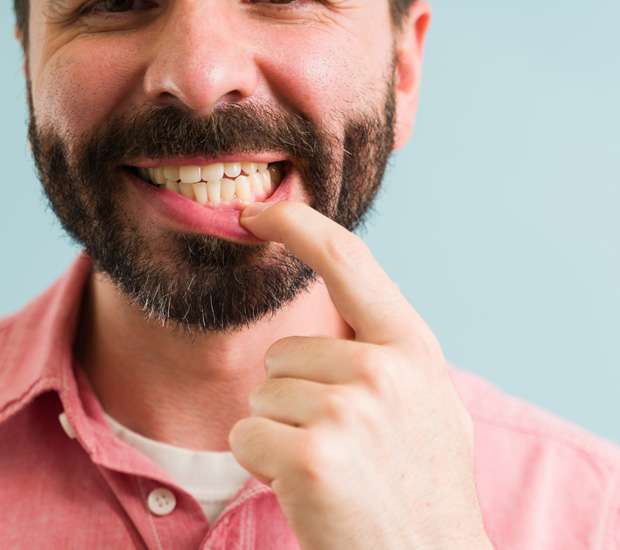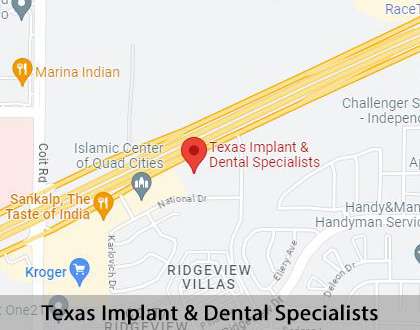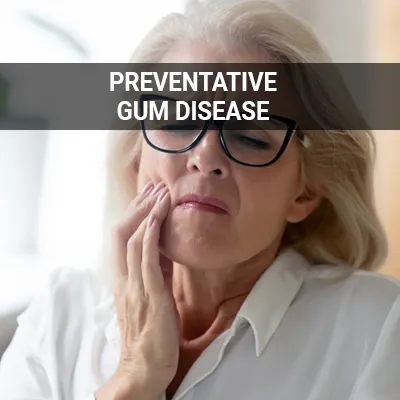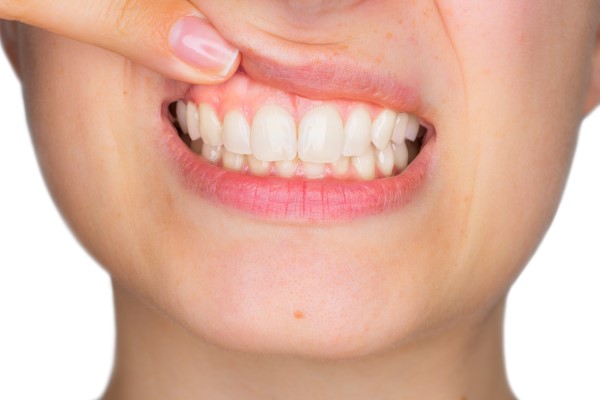Regenerative Procedures Plano, TX
Regenerative procedures restore bone and tissue loss due to gum disease. Periodontal or gum disease results from built-up plaque, which causes bacteria that break down tissue that supports the teeth. Regenerative periodontal surgery can rebuild lost tissue and bone, restoring overall health and functioning.
Regenerative procedures are available at Texas Implant & Dental Specialists in Plano and the surrounding area. Call us at (972) 535-6555 to learn more or schedule an appointment.
What are Regenerative Procedures?
Regenerative procedures reverse some of the effects of periodontal disease, which is a condition that results in the loss of tissue and bone that support the teeth. Some types of treatments can recreate tissues broken down due to gum disease. However, the primary purpose of regenerative procedures is to return teeth and gums to their original healthy state.
Periodontists typically perform regenerative procedures. These professionals receive up to three years of training beyond dental school. Periodontists diagnose, treat, and help prevent periodontal or gum disease. They can also place dental implants and perform dental surgery.
“Periodontists diagnose, treat, and help prevent periodontal or gum disease.”
Conditions that Require Regenerative Procedures
Regenerative procedures treat bone and gums affected by periodontal disease, which stems from plaque accumulating under the edge of gums. Patients who smoke, have dry mouth (Xerostomia), or take certain medications tend to experience more plaque build-up and need professional cleanings more often to reduce their risk of gum disease.
Reducing bacteria that contribute to bone and tissue loss can help prevent the need for regenerative procedures. In addition, regular brushing, flossing, and dental check-ups can remove plaque, which contributes to the need for periodontal treatments. Healthy eating and limiting sugar consumption, especially for patients with diabetes, can also help keep teeth and gums healthy.
“Reducing bacteria that contribute to bone and tissue loss can help prevent the need for regenerative procedures.”
Types of Regenerative Procedures
Different types of regenerative procedures exist depending on the nature of the periodontic damage to the affected area. One type is bone grafting, which helps rebuild the diminished bone around the teeth. During the procedure, the periodontist places material that helps stimulate growth in the remaining bone and then sutures the gums after the graft.
Periodontists also perform guided tissue regeneration to recreate lost tissues. Like bone grafting, the treatment involves placing a biocompatible membrane around the area of bone damage to isolate it, allowing for new bone to grow as the membrane dissolves. The periodontist then sutures the gums.
There is also cell stimulation, which involves injecting protein material between the tooth and surrounding bone. This cell-stimulating material, which isolates the damaged area, encourages more bone growth. The procedure concludes with gum suturing.
“Different types of regenerative procedures exist depending on the nature of the periodontic damage to the affected area.”
Check out what others are saying about our dental services on Yelp: Regenerative Procedures in Plano, TX
Benefits of Regenerative Procedures
When combined with oral hygiene habits that reduce the risk of bacteria, regenerative procedures can effectively restore bone and tissue and maintain oral health. Regenerative periodontal treatments also reverse some of the damage that advanced gum disease can cause.
Other benefits include the provision of a deep clean and the prevention of future periodontal disease. Regenerative procedures can restore function by strengthening the gums and teeth. The loss of bone and tissue can cause pain, limiting chewing, talking, and other necessary movements.
“Regenerative procedures can restore function by strengthening the gums and teeth.”
Questions Answered on This Page
Q. What is the purpose of a regenerative procedure?
Q. What conditions require regenerative procedures?
Q. What different types of regenerative procedures do periodontists perform?
Q. What are the benefits of undergoing a regenerative procedure?
Q. What happens during a regenerative procedure?
People Also Ask
Q. What are the complications from ignoring preventative care?
Q. What are some reasons to visit a periodontist?
Q. What sort of conditions does periodontics cover?
What the Procedures Might Entail
Regardless of the method a periodontist uses, the primary purpose of a regenerative procedure is to remove the bacteria that cause disease and rebuild the bone and supportive tissues. Most treatments require flap and osseous surgery, during which the periodontist pulls back the gum tissue to remove the bacteria and insert any regenerating material. The periodontist also sutures the gum to help reattach it to the tooth.
Patients needing a regenerative procedure can take several steps to prepare for treatment. For instance, patients might need to stop taking certain drugs, such as aspirin, blood thinners, and pain relievers, about two weeks before the procedure. Abstaining from smoking and alcohol the day before surgery is also ideal. Patients might also get an antibiotic prescription beforehand to ward off infection. Finally, individuals should arrange for a ride home after surgery.
“Regardless of the method a periodontist uses, the primary purpose of a regenerative procedure is to remove the bacteria that cause disease and rebuild the bone and supportive tissues.”
Frequently Asked Questions
Q. What is periodontics?
A. Periodontics is a dental specialty that focuses on conditions affecting gums and other material that supports the teeth. Dentists who perform regenerative procedures are typically periodontists. They place dental implants and perform surgeries that repair damaged gums. These professionals receive about three years of training beyond dental school.
Q. Are regenerative procedures painful?
A. Getting a regenerative procedure can alleviate the pain that bone and tissue loss caused in the first place. Periodontists are skilled at preventing procedure-related pain and making patients more comfortable during treatment. Also, proper aftercare can help reduce pain, especially after surgeries that involve grafting or opening of flaps.
Q. How would I know which type of regenerative procedure is the best treatment for me?
A. A periodontist treating bone and tissue loss will help a patient determine which procedure is appropriate. This decision gets based on the extent and location of the bacteria and damage. Patients should not hesitate to ask their periodontist any questions that clarify any confusion about treatment, especially if it might reduce their fears.
Q. What can I do to avoid needing a regenerative procedure?
A. Good oral hygiene is perhaps the easiest and most important thing individuals can do to maintain strong teeth and gums, thus reducing their risk for gum disease. For example, brushing twice a day and flossing can help prevent gum disease. Regular dental check-ups and cleanings can also ward off the damage-causing bacteria that lead to the loss of bone and supporting material.
Q. What should patients expect for recovery from a regenerative procedure?
A. Most patients can resume normal eating and regular activities about a day after a regenerative procedure. It is not unusual for there to be slight bleeding or discomfort after any periodontal surgery. A patient's recovery typically depends on the type of treatment they received, the extent of their damage, and general health. The periodontist might prescribe a mouth rinse or antibiotic to prevent inflammation and ensure proper healing.
Start Feeling Better – Visit Us Today
By visiting us as soon as possible, our team can help get you the professional treatment you need. Instead of waiting around and allowing the symptoms to get worse, we can provide you with treatment options.
Definitions
Learn More about Regenerative Procedures
Regenerative procedures restore oral health and functioning by rebuilding lost bone and tissue that typically results from periodontal or gum disease. There are different regenerative procedures, including bone grafting, guided tissue regeneration, and cell stimulation. Contact Texas Implant & Dental Specialists in Plano to learn more about regenerative procedures. Call us at 972-535-6555 to schedule an appointment.
Helpful Related Links
- American Academy of Periodontology (AAP). American Academy of Periodontology (AAP). 2023
- Center for Disease Control and Prevention (CDC), Periodontal Disease Page. Center for Disease Control and Prevention (CDC), Periodontal Disease Page. 2023
- WebMD, What Is a Periodontist?. WebMD, What Is a Periodontist?. 2023
About our business and website security
- Texas Implant & Dental Specialists was established in 2007.
- We accept the following payment methods: American Express, Cash, Check, Discover, MasterCard, and Visa
- We serve patients from the following counties: Collin County, Denton County and Dallas County
- We serve patients from the following cities: Plano, Frisco, Allen, McKinney, Garland, Richardson, Prosper, Wylie, Murphy, and Dallas
- Norton Safe Web. View Details
- Trend Micro Site Safety Center. View Details
Back to top of Regenerative Procedures










